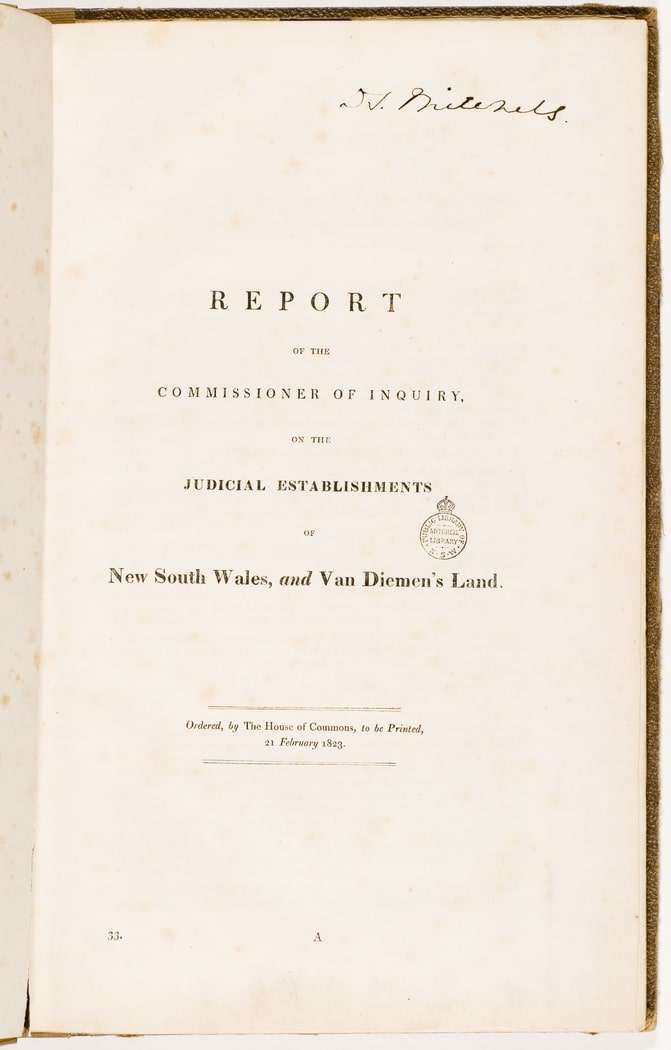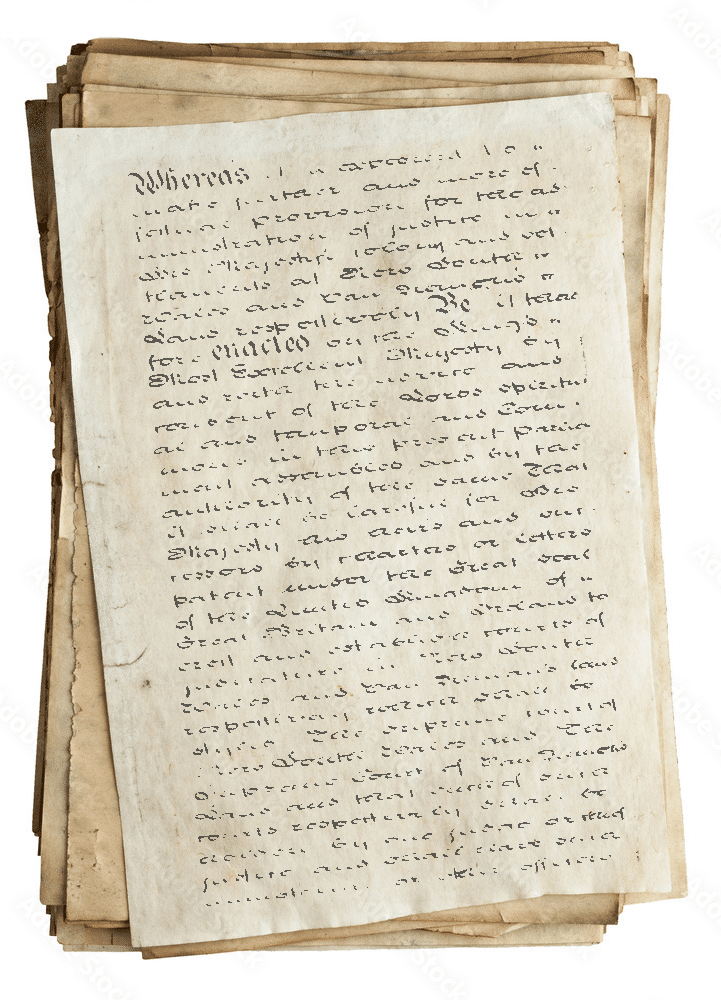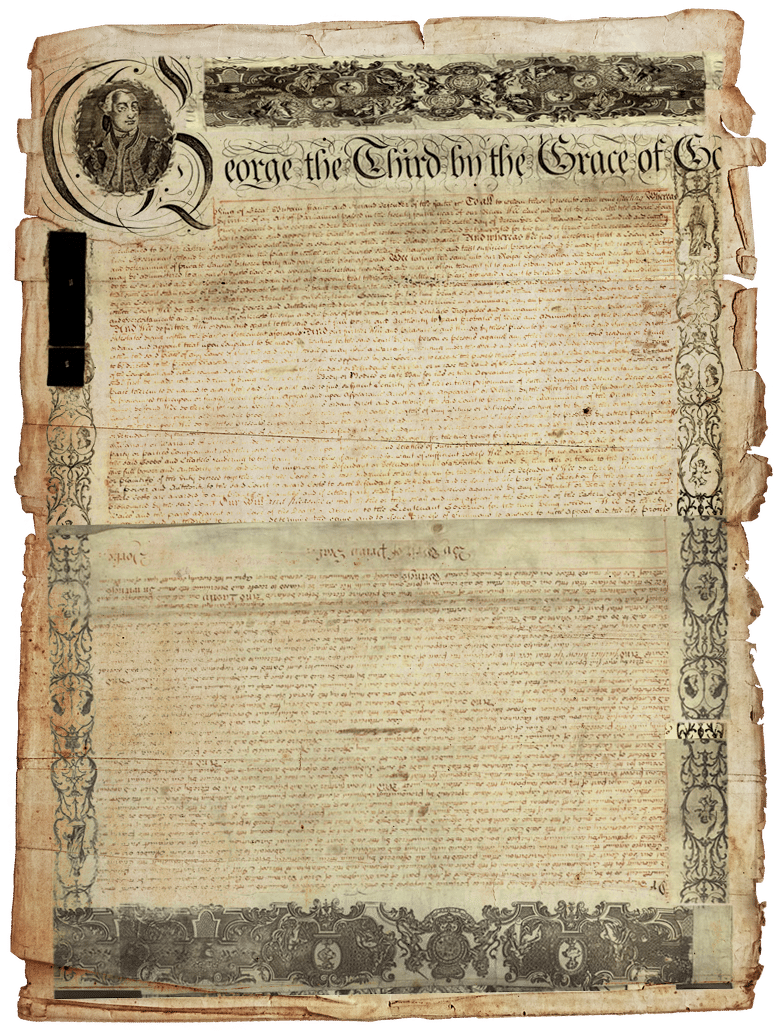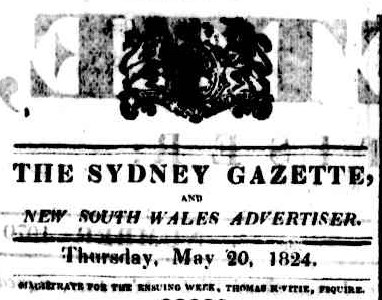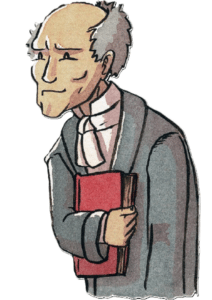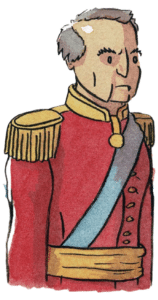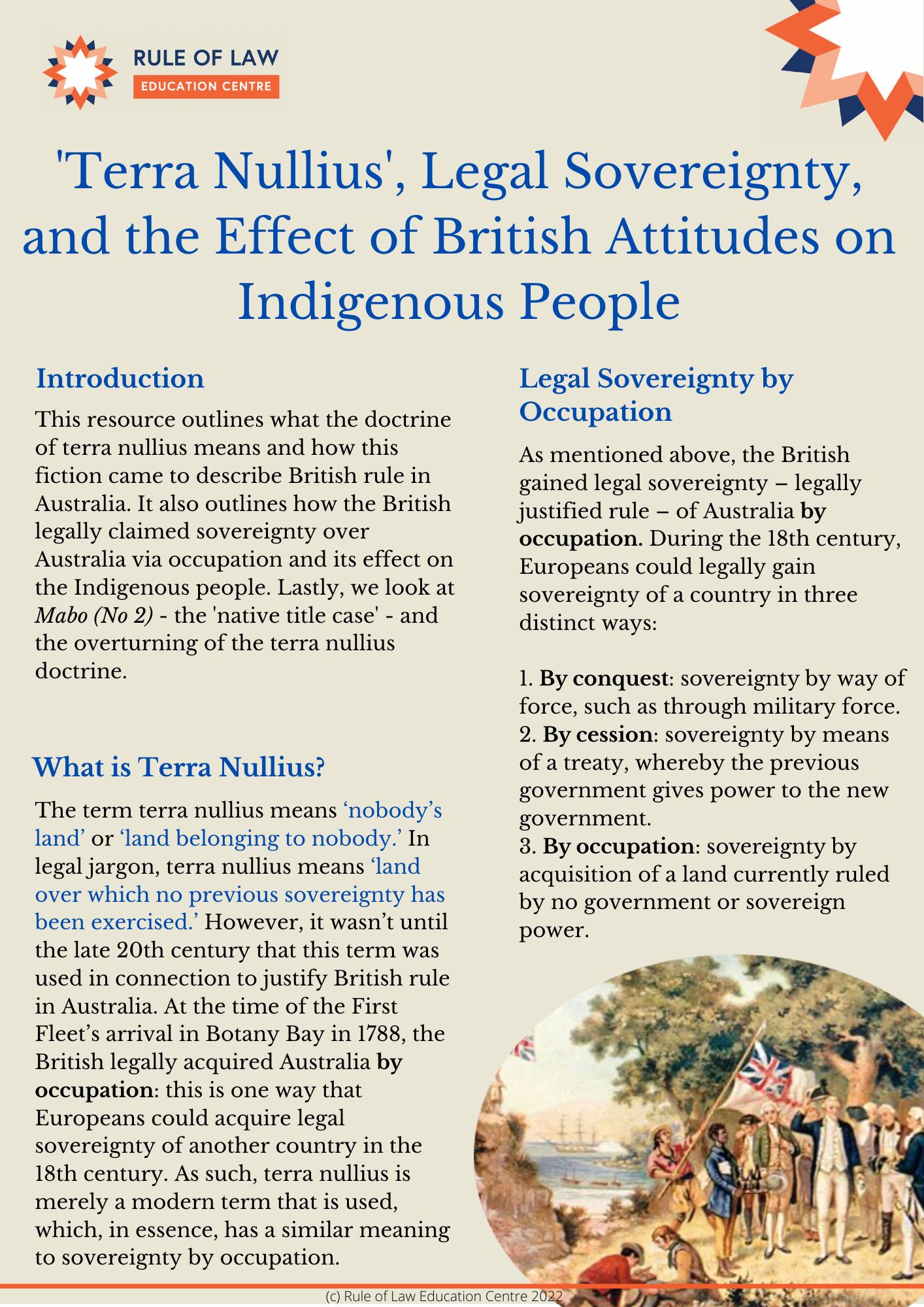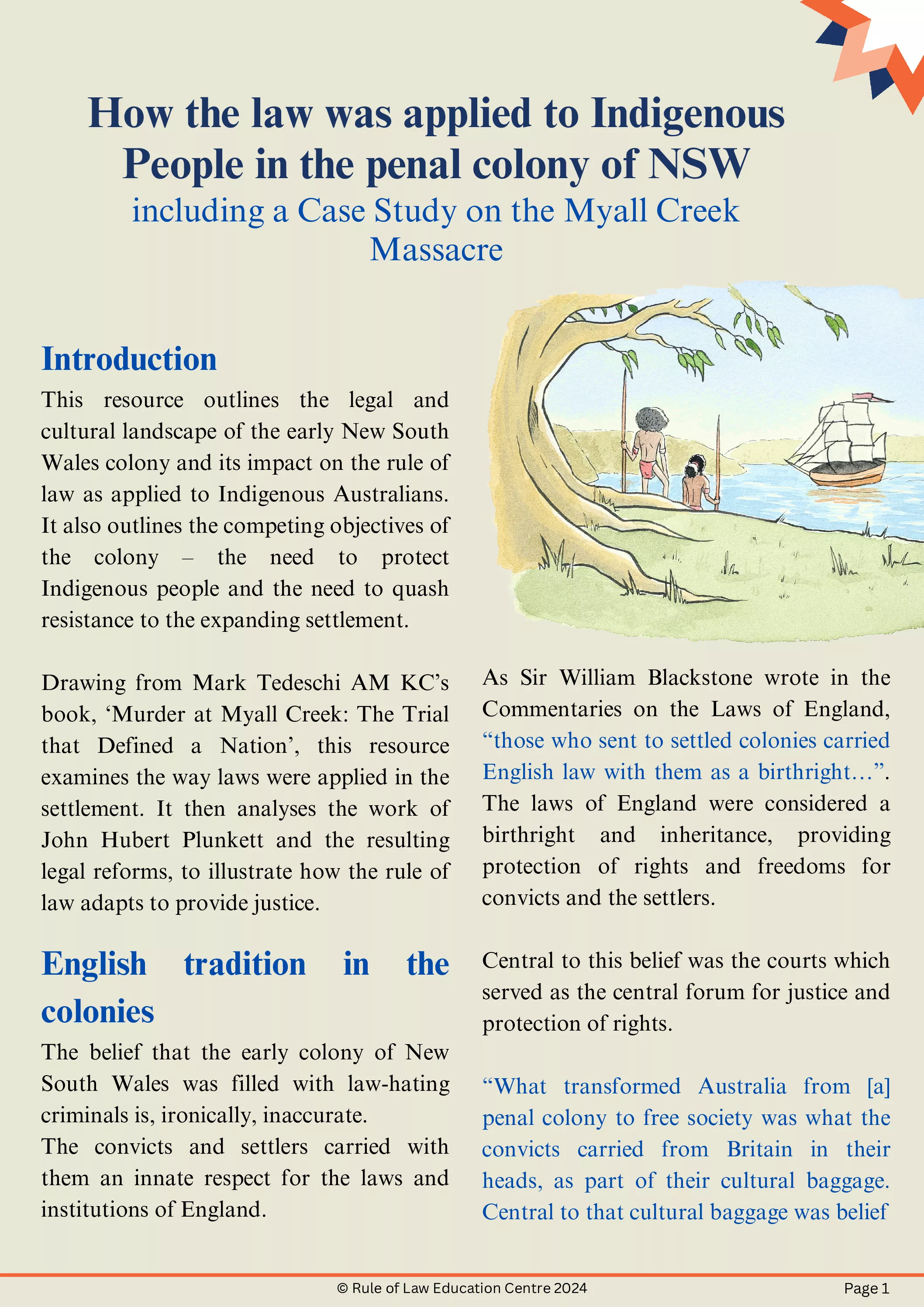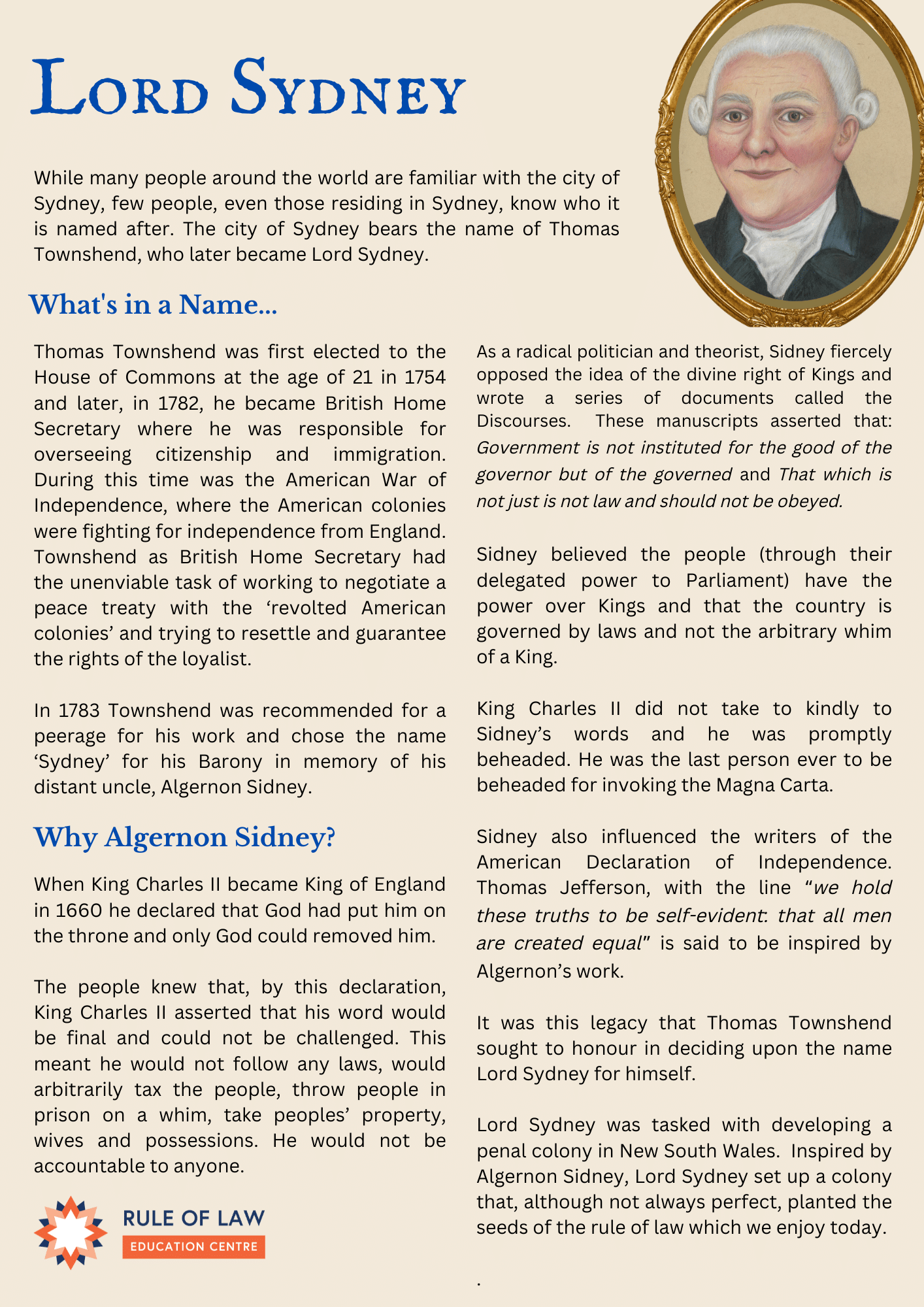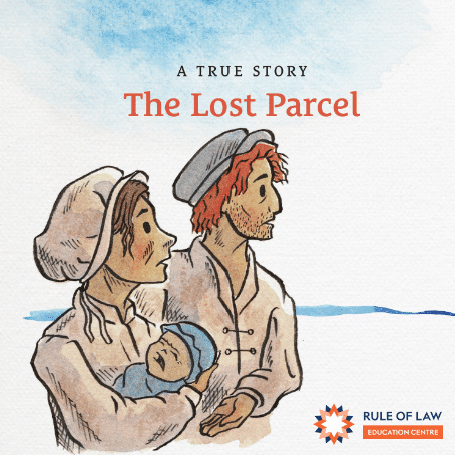Francis Forbes and the Protection of Rights in the NSW Penal Colony
Looking at how the change in the New South Wales Governance structure through the establishment of the NSW Supreme Court, with Chief Justice, Sir Francis Forbes and the free press, protected rights in the new colony.
From the earliest of days of the NSW Penal Colony, the values and institutions that underpin Australia’s democratic form of government were present. The concept of the separation of powers, with an independent judiciary and freedom of speech (through the free press), were important elements that protected the rights of citizens (both convicts and free) and contributed to a fair society.
These ideals have not been static nor perfectly realised. They have required re-evaluation and reform by brave Australians who have stood up when the protections were not available to all in society.
The story of Checks and Balances: Press Freedom and an Independent Judiciary is about one such person, Chief Judge Forbes. 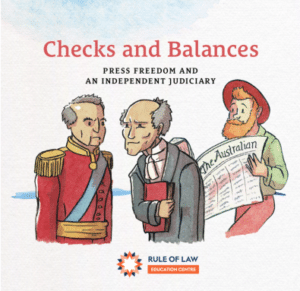
It is a story of the tension between Governor Ralph Darling, who had been sent to the colony to rebuild it as a place of ‘terror’ for the convicts who had been sentenced there, and Chief Justice Forbes, whose duty it was to administer justice through the courts and ensure that the rule of law was upheld by all… even the Governor! This book highlights the important role that checks and balances such as an independent judiciary and free press had in the new colony.
Case Method looking at the decision of Chief Justice Francis Forbes to develop an understanding of an Independent Judiciary and the free press
The Rule of Law Education Centre has created resources to help teachers use the Case Method to look at the story of Chief Judge Francis Forbes to develop an understanding of current civic concepts and to consider “if you were Chief Justice Forbes in the early colony of NSW, would you allow a free press?.” Resources can be found here and include Case Summary, Case Exhibits, Discussion Question and the Outcome.
Education Resources
Primary and Secondary sources enable students to connect to events in the past.
To assist teachers and students, the Rule of Law Education Centre has collated important sources to enable the interpretation of history.
Sources include both formal court and government documents and also personal accounts found in letters and newspaper articles.
Source Documents and the NSW Supreme Court
Many original source documents can be accessed to illustrate the history of the establishment of the NSW Supreme Court. Starting with the Bigge Reports that recommended changes to the administration of Justice, the introduction of the 1823 NSW Act and the Letters Patent which legislate these recommendations, we have an accurate idea of how the justice system of Australia developed in its earliest stages.
But the formal documents only tell us part of the story. Newspaper articles and letters from the time reveal the extent of the battle between Governor Darling, a military man who believed in maintaining order through strict rules and punishment, and the new Chief Justice who believed ‘the judicial office itself stands uncontrolled and independent, and bowing to no power but the supremacy of the law.’
Below we have collated many of the key documents and provided links to other sites that hold these valuable historical records.
Earl Bathurst shows concerns as Secretary of State for the Colonies
1817
Earl Bathurst was a politician responsible for the administration of the British Colonies (including NSW) from 1812-1827. He wrote a letter dated ‘Downing Street, 23rd April, in 1817’ to Lord Sidmouth stating:
“Transportation to New South Wales is becoming neither an object of Apprehension here nor the means of Reformation in the Settlement itself, and that the Settlement must be either placed upon a footing that shall render it possible to enforce, with respect to all the Convicts, strict Discipline, Regular Labour, and constant Superintendance, or the System of unlimited Transportation to New South Wales must be abandoned.”
Bathurst commissioned an inquiry into the administration of the NSW colony.
The Bigge Reports
June 1822 (1st), February 1823 (2nd) & March 1823 (3rd)
Commissioner John Thomas Bigge was sent to the colony to report on ‘the state of the settlements in NSW and its dependencies, and the laws, regulations and usages, civil, military and ecclesiastical.’ His instructions were to make recommendations in light of the assumption that the settlement that was a place of punishment and reformation and a ‘receptacle for offenders’ where transportation should invoke ‘real terror.’
The 2nd Bigge Report, ‘The Judicial Establishments of NSW and Van Diemen’s Land’ and Bigge’s private appendices to Bathurst formed the basis of The NSW Act as drafted by Francis Forbes.
The NSW Act 1823 (UK)
19 July 1823 (4 Geo. IV Act No .96)
The substance of the NSW Act was based upon recommendations in the Bigge Report for the “better Administration of Justice” in the colony and was passed by the British Parliament in 1823.
In addition to a nominated Legislative Council, the Act established the Supreme Court of New South Wales and gave the Chief Justice the power to veto any proposed legislation if it was not consistent with English law (so far as the circumstances permitted).
Furthermore, the NSW Act gave the Supreme Court a powerful supervisory jurisdiction over magistrates in the inferior courts.
Third Charter of Justice
13 October 1823
Otherwise known as Letters Patent. Letters patent are issued by a monarch granting an office or creation of an office.
This letter was issued by the King of England, George IV and is authorised by Statute, being the NSW Act, which it describes as an Act ‘for the better administration of Justice in New South Wales and Van Diemens Land and for the more effectual Government thereof.’ The Letters established the NSW Supreme Court and allowed for the appointment of Judges and Chief Justices to the Courts and the conditions of their employment.
Together with the NSW Act, the Charter forms the legal basis for the establishment of the Supreme Court.
The Sydney Gazette
April 1824
The Sydney Gazette contained a proclamation from Governor Brisbane that the Supreme Court was to be established on Monday 17th May 1824, with Francis Forbes as the new Chief Justice.
“His Majesty hath been graciously pleased… to establish a Court of Judicature in the Colony… and to appoint FRANCIS FORBES, Esquire, Barrister at Law, to be the CHIEF JUSTICE of the said Court.”
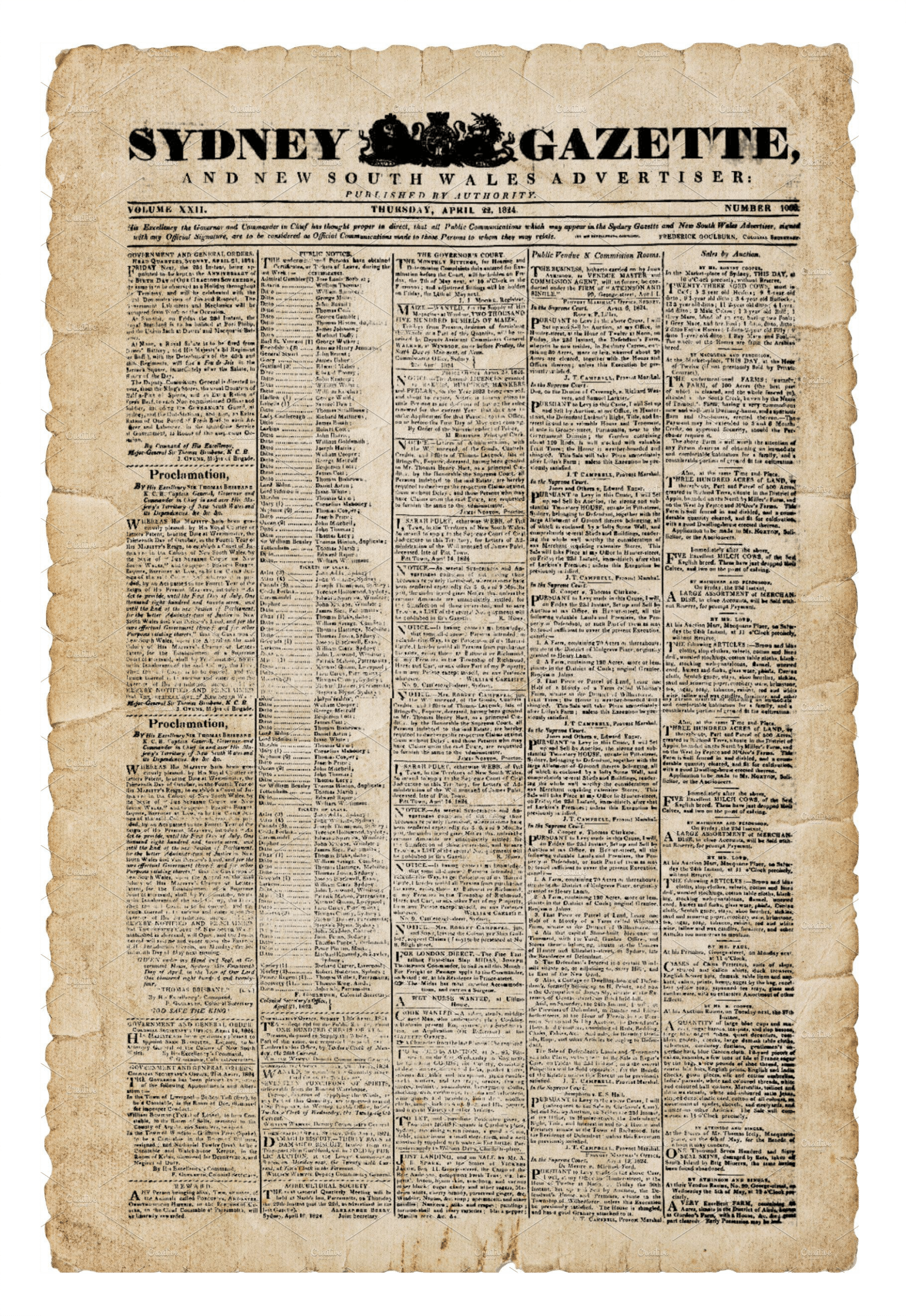
Proclamation Establishing the Supreme Court
17 May 1824
Pursuant to section 18 of the NSW Act 1823, upon the arrival of the Letters Patent to the colony, the Governor ‘shall by proclamation notify to the inhabitants of the said colony the time when the said courts respectively are to be opened.’
The Sydney Gazette on 20 May 1824 stated ‘The formal promulgation of His Majesty’s New Charter of Justice, took place at noon, on Monday last… At two o’clock .. this court opened.. At three, the Charter was proclaimed in the Market-place. .. His Excellency the Governor entertained his Honor the Chief Justice.. at dinner- in honour of a day that will long be remembered by the grateful inhabitants of Australia’
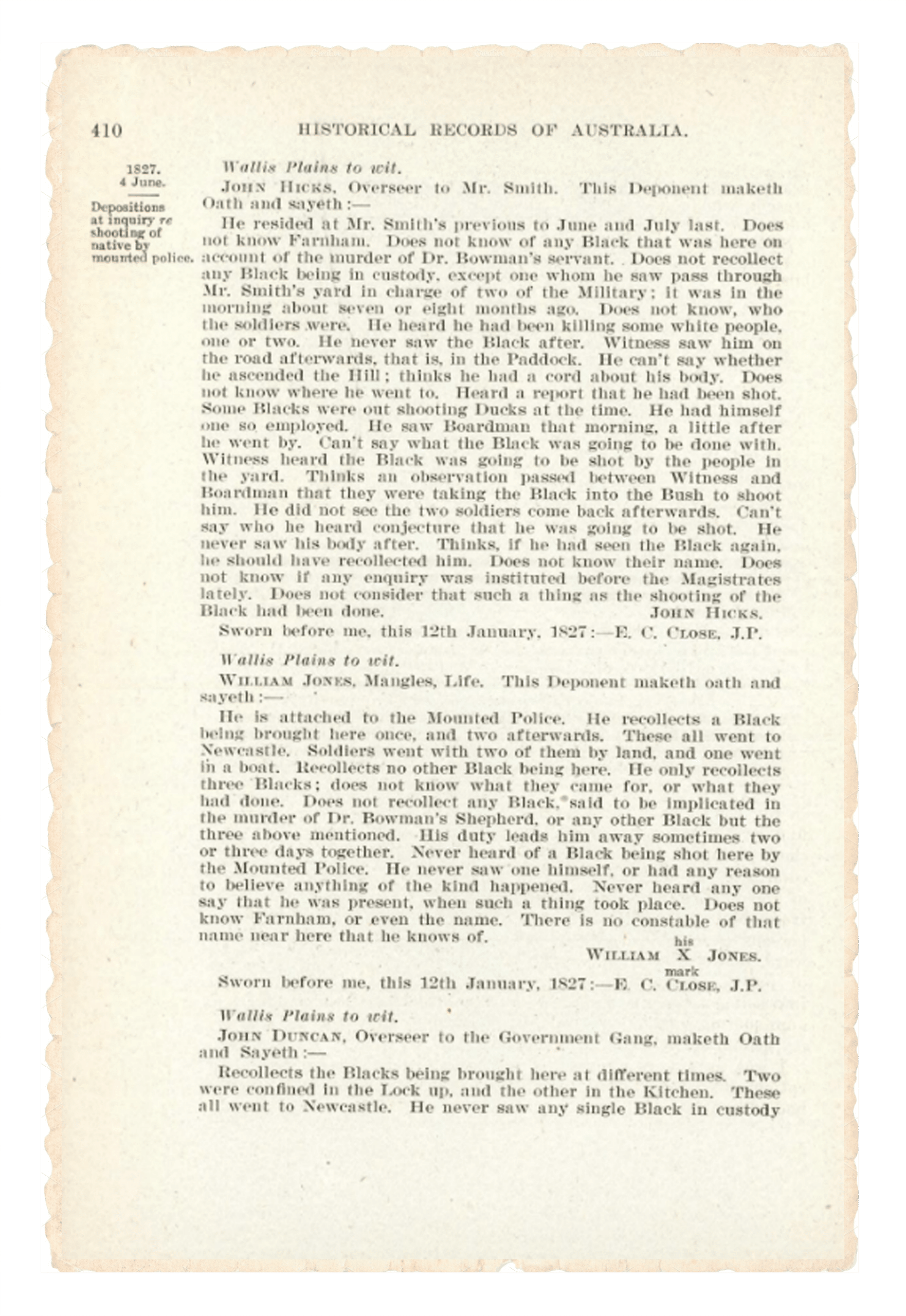
Letters between Forbes and Horton
September 1827
Letters between Chief Justice Forbes and Under-Secretary Wilmot Horton detail the initial period of Governor Darling’s governance and his gradual decline in the public’s confidence. The letters also discuss Forbes’ suspicion that Darling saw the courts as an threat to his power. In the letter Forbes writes, ‘The powers of the government have been at once legislative, judicial and executive; your act abridged all these powers, and created the Supreme Court, a check, indeed a controlling authority.” Further he wrote, ‘the people of this country… naturally regard the Supreme Court as their only protection against absolute power”.
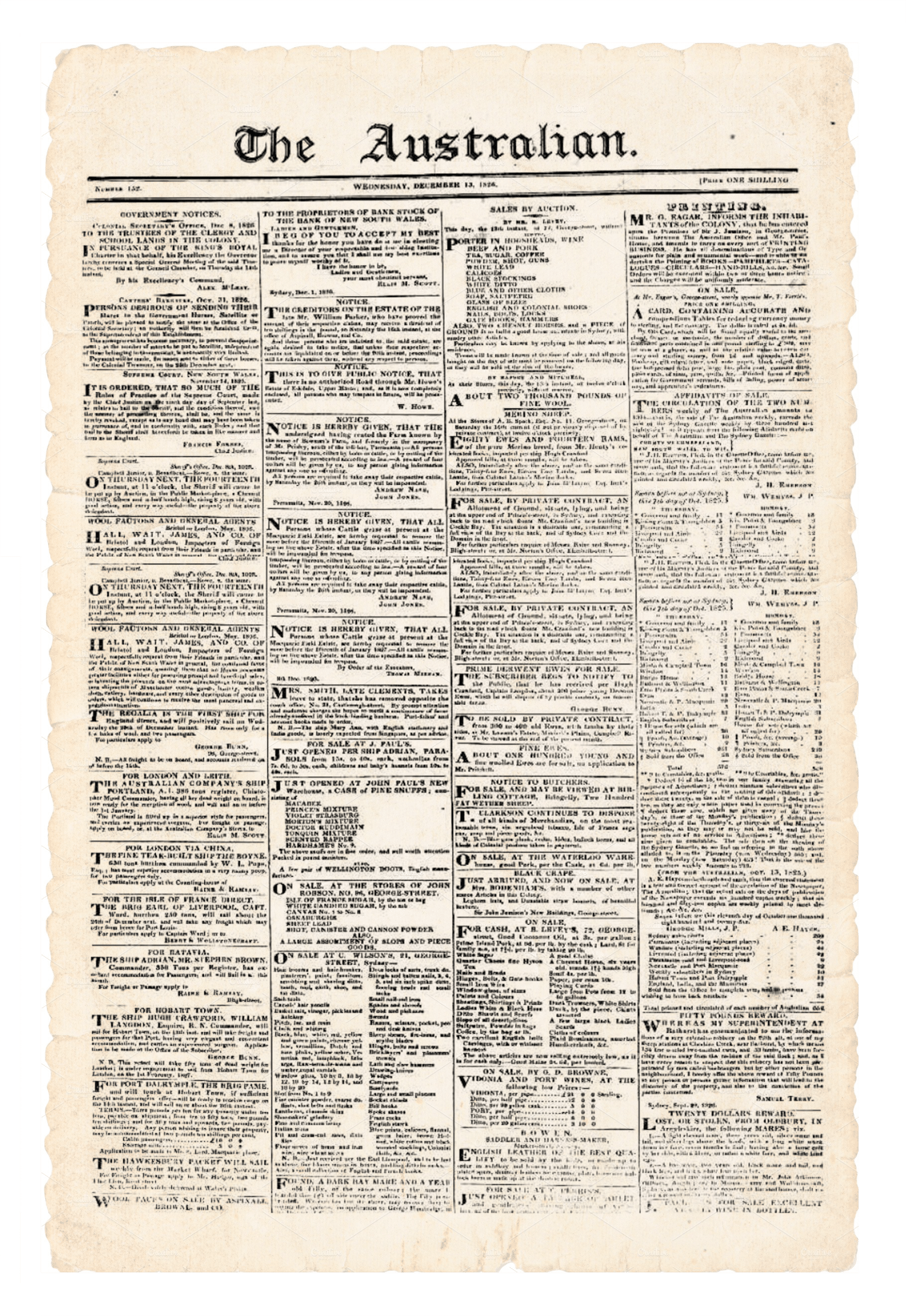
The Australian Newspaper (1826)
December 1826
This issue of The Australian illustrates the public outrage in response to the death of a soldier, Thomas Sudds, as a result of what was deemed one of the most controversial instances of punishment under the law at the time.

The Australian Newspaper (1827)
May 1827
This article of The Australian was written in response to a new tax proposed by Governor Darling, which ordered a tax of four pence on each newspaper bought. Many accused the Governor of trying to silence the newspapers due to his declining popularity.
“Imposing a duty of four-pence on Newspapers, is and must be repugnant to the laws of England.”
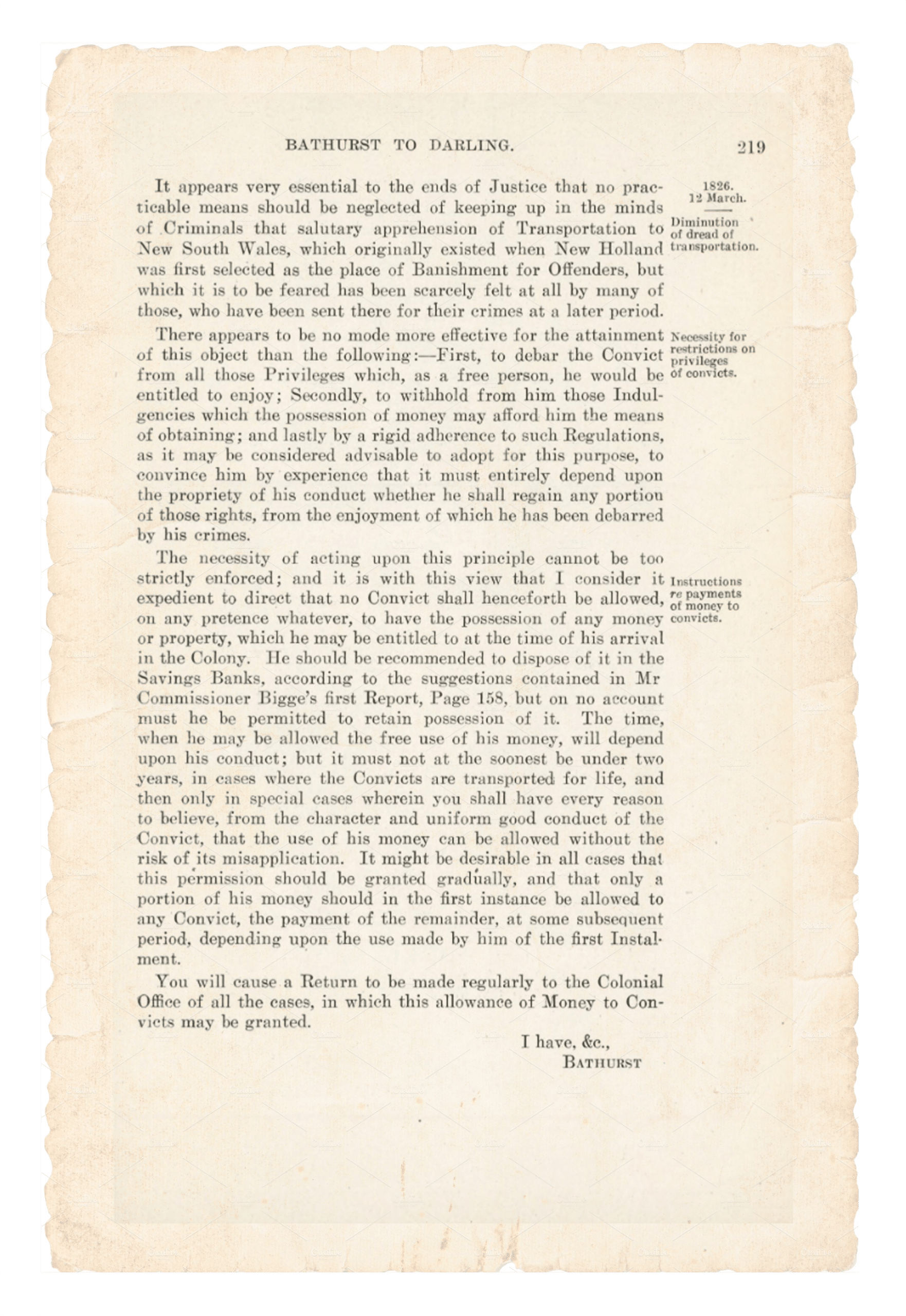
Letters From Bathurst to Darling
MARCH 1826
These letters from Lord Bathurst to Governor Darling detail the instructions given to Darling, and the outcomes he was to achieve. In particular, Darling was to make the colonies a place “to be feared” and to restrict many of the rights that the convicts had at the time.
Key Characters in Checks and Balances Story
Chief Justice Francis Forbes: 1784 – 1841 
Career
In 1803, Forbes, aged 19, went to London to study law. After a few years he returned to his birthplace, Bermuda, where he was officially appointed as attorney-general in 1811 and King’s advocate in the Vice-Admiralty Court in 1813.
In 1816, he was appointed as the Chief Justice of Newfoundland, a position he would hold until 1822. In this position he lawfully opposed the Admiral-Governors and declared their proclamations as null and void.
Whilst on leave in London, he co-authored the New South Wales Act 1823 which established the New South Wales Supreme Court.
In 1824, Forbes became the first Chief Justice of the newly created Supreme Court of New South Wales.
Unique Position in the Colony
Under the New South Wales Act 1823 Chief Justice, Francis Forbes was the head of the New South Wales Supreme Court and also a member of the newly formed Legislative Council. The Act required the Governor to gain Chief Justice Forbes approval before passing any new laws to ensure they were not ’repugnant to the laws of England.’
Personal Attributes
Forbes took great interest in the idea of freedom, strongly admiring how the notion of an independent judiciary could protect the freedoms of citizens. He was not easily swayed by others, and stayed firm in his beliefs despite opposition.
Contrary to the usual English tradition for judges, he refused to wear a judge’s wig. The other judges (who wore wigs) said it gave him a ‘republican look.’
Later Life and Death
Francis Forbes brought a personal library of 500 law books with him to New South Wales.
Francis Forbes retired and was honored with a Knighthood in 1837
He passed away at age 57 on 8 November 1841 in Newtown.
Francis Forbes was the Chief Justice of the Supreme Court NSW (from 1824 to 1837)
His role as the Chief Justice of NSW saw him act as a check on the Governor’s power and protected the freedoms, such as freedom of the press, of those in the colony.
Francis Forbes was described as “the model of an excellent judge” -Roger Therry, practitioner
“He was rather short in stature, spare in figure, his eyes were bright and intelligent, and his face was
certainly a pleasant one. He had a judicial mind, and earned for himself the reputation of being a
conscientious as well as a constitutional judge.”
– Judge Dowling
“a man whose courage was equal to his capacity”
– Samuel Bennett
The Historical Records of Australia, Series 1, Volume 12 and 13 contain many letters between Francis
Forbes, Governor Darling and Under Secretary Horton
Governor Ralph Darling: 1772 – 1858
Career 
Governor Ralph Darling was a British Military Officer, who was appointed Governor of New South Wales from 1825-1831.
In 1793, at age 14, Darling enlisted as a private in the 45th regiment (his father’s regiment) and served in the West Indies for two years. Darling was then promoted to captain in 1796, major in 1800 and later a lieutenant-colonel. In 1806, Darling became senior assistant adjutant general at the Horse Guards, before going to Spain in 1808 with the 51st Regiment and serving at the battle of Corunna. The subsequent year, Darling served in the Walcheren expedition. He was promoted major-general in 1813 and served as deputy adjutant general in 1814.
Between 1819-1824, General Darling commanded the British troops on Mauritius. He was then appointed Acting Military Governor of Mauritius, and worked to end the enslavement of 70,000 sugar cane workers and the slave trade practices with Madagascar.
In 1824, Darling was appointed governor of New South Wales (replacing Sir Thomas Brisbane). He was given ‘Instructions’ in the form of letters from Earl Bathurst. These Instructions directed Darling in his role of Governor of the colony.
As Governor, Darling introduced improvements to the machinery of the colonial government (i.e. a supervised civil service) and integral monetary and banking reforms. Governor Darling was assisted by the newly constituted Executive Council, comprising of the lieutenant-governor, chief justice, colonial secretary and the archdeacon of the Church of England.
Personal Attributes
Governor Darling had full confidence in the military hierarchical structures – it facilitated orders being followed, and aligned with his position as an ultra-conservative, to which the old establishment revolved around.
Later Life and Death
Governor Ralph Darling left Australia in 1831. A parliamentary inquiry was conducted to examine his conduct in New South Wales. Despite scrutiny, Darling was exonerated and knighted by the King, in a display of official favour. He died in Brighton, England on 2 April 1858.
Governor Ralph Darling was born in Ireland, in 1772, to Christopher Darling, Adjutant General of the 45th Regiment
Governor Darling was described as “his excellency is not as tall and as straight as a poplar tree. He has a
courtier like bend.. he is quite erect when walking and fully able to carry that soldier like position, which attention commands.. The countenance betrays tranquility of mind .. a smooth placid firmness, without anything of the stern or overbearing in his composition”
-The Australian 22 December 1825
“a narrow minded man, who was not naturally of a cruel disposition, but who, having been trained in an
arbitrary military school, had acquired despotic habits and imbibed a contempt for legal rights and constitutional forms and privileges, which rendered him wholly unfit for the position in which he was placed”
-Samuel Bennett

